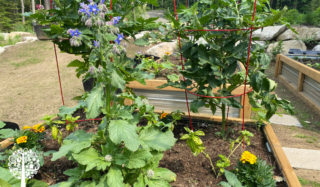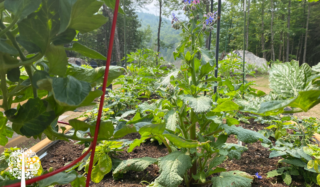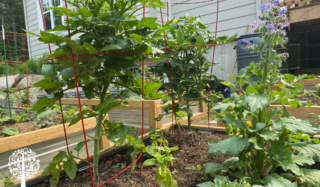
Organic-Regenerative Gardeners, Here’s The Buzz About Borage
While getting some much-needed garden therapy at my local nursery recently, I came across a spectacular-looking plant that I decided I must have in my raised beds: borage. I didn’t know much about it then, but it was impressive-looking, with its tall, fuzzy stem, lush leaves, and purple-blue, star-shaped flowers. It was calling my name! A stunning plant like this must offer some benefits. Lucky for me and organic-regenerative gardeners everywhere, it does!

The Pros
Borage is part of the same family as comfrey; if you’re related to comfrey, you must be good.
To some, borage may not seem more than a common weed. Yes, this annual self-seeds and will spread quickly in the garden if you don’t collect and destroy flower heads going to seed. But I say let it spread. You’ll understand why after reading all the pros!
Companion Planting
Borage looks fantastic and is an excellent companion plant for beans, tomatoes, strawberries and squash, repelling pests such as tomato hornworms and the imported cabbageworm.
Pollinator-Attracting
It also produces dozens of flowers and a ton of nectar, attracting honeybees, bumble bees, native bees, and butterflies in droves! If pollinators love it, I do too.
Soil-Feeding
It works overtime as a living mulch and can be chopped and dropped into the soil to add fertility to the garden after the growing season.
Need we say more about why you should include borage in your vegetable garden? Okay, if we must!
Eating Borage
How about the fact that it’s a historic medicinal herb used to treat fever and cough? The leaves and flowers are edible and taste a bit like cucumber. Eat the leaves in salads, soups, and more.

In her book, The First Time Gardener: Growing Vegetables, Jessica Sowards recommends serving the flowers in salads or freezing them in ice cubes to add color and flavor to cold drinks.
Disclaimer
But according to The Old Farmer’s Almanac, some herbalists believe borage can be toxic to the liver. Fresh leaves can also cause contact dermatitis, so please research and speak with an expert before harvesting.
Borage In My Garden
I’m using my borage plant as a pollinator-attractor, pest-deterrent, and living mulch.
I’ve already noticed an abundance of bees around the plant!

Borage likes full sun and filtered sunlight, so I’ve tucked it between my tomato plants, and it seems very happy there. The soil in my raised beds is excellent, but it will grow almost anywhere, including sandy and slightly poor soils.
This plant grows anywhere between one and three feet tall and doesn’t like to be transplanted, so try to find one in a peat pot that you can plant directly into the ground.
So, that’s the buzz about borage. I’m glad it’s in my garden, how about you?

- Catherine Sherriffs
